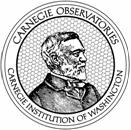
- Home
- Quick Facts
- Exposure Calculator
- Calibration
- Manual & Documents
- About Us
- Optics
- Mechanical
- Electronics
- Software
- Pictures
- Calendar
- Status
Technical Staff Links
FourStar Calibration
| FILTER | Gain |
Read Noise | Well Depth | Typical Background | Typical Background | AB Mag | Vega Mag | ||
|---|---|---|---|---|---|---|---|---|---|
[e-/ADU] |
[e-] | [e-] | [e-/s/pix] | [mag/sq"] | Zeropoint [e-/s] | Depth1 | Zeropoint [e-/s] | Depth1 | |
| J1 (Y) | 2.51 |
20 |
143,000 |
200 |
16.9 |
27.3 |
25.4 |
26.6 |
24.7 |
| J | 2.51 |
20 |
143,000 |
850 |
15.6 |
27.9 |
25.7 |
26.9 |
24.4 |
| H | 2.51 |
20 |
143,000 |
4100 |
13.8 |
28.1 |
24.8 |
26.8 |
23.5 |
| Ks | 2.51 |
20 |
143,000 |
3100 |
13.1 |
27.9 |
24.5 |
25.8 |
22.7 |
1. Depths are the 5.0-sigma background fluctuations within a 0.7" circular aperture in 1 hour (no correction for light outside aperture).
Total magnitudes for point sources at 0.5" seeing are approximately 0.7 mag brighter.
FourStar Standards
Spectrophotometric standards were convolved with the FourStar bandpasses to create a set of standard stars of appropriate brightness.
The stellar SED data are available from: http://www.stsci.edu/hst/observatory/cdbs/calspec.html
| HST Standard | J1(Y) | J | H | Ks | ||||||
|---|---|---|---|---|---|---|---|---|---|---|
| RA | DEC | Name | AB | VEGA | AB | VEGA | AB | VEGA | AB | VEGA |
| 03:32:32 | -27:51:48 | C26202 | 16.285 | 15.607 | 16.313 | 15.395 | 16.446 | 15.083 | 16.883 | 15.034 |
| 05:52:27 | 15:53:16 | GD71 | 14.309 | 13.631 | 14.612 | 13.693 | 15.152 | 13.789 | 15.744 | 13.894 |
| 12:57:02 | 22:01:56 | GD153 | 14.652 | 13.974 | 14.958 | 14.040 | 15.503 | 14.140 | 16.112 | 14.262 |
| 16:18:14 | 00:00:08 | SF1615+001A | 16.271 | 15.594 | 16.278 | 15.360 | 16.345 | 14.982 | 16.753 | 14.903 |
| 23:19:58 | -05:09:55 | FEIGE110 | 13.107 | 12.429 | 13.432 | 12.514 | 13.983 | 12.620 | 14.593 | 12.743 |
| 21:32:16 | 00:15:14 | LDS749B | 15.555 | 14.878 | 15.817 | 14.898 | 16.295 | 14.932 | 16.846 | 14.997 |
FourStar Linearity
Linearity correction maps are provided for each array for the FullWell mode and the LoNoise mode. The filename is divided into 2 parts: the gain setting and the chip number. The deviation from linearity is a single term of order 2.5. The data were taken using dome flats with the H filter at varying exposure times scaled by interspersed 10s exposures. The data were fit as:
exptime = A[0]*raw + A[1]*raw**2.5 + A[2]
The coeffiecient A[0] represents the (inverse) linear gain of the pixel in units of [s/ADU]. The true expected counts are determined by dividing by A[0]:
True counts = exptime/A[0] = raw + A[1]/A[0]*raw**2.5 + A[2]/A[0]
The coeffiecient A[1]/A[0] represents the non-linear correction and the term A[2]/A[0] is representative of the read noise (in ADU).
These coefficients are stored in an image cube for each array. The cubes contain three layers: The first is A[0] which provides an indication of the pixel-to-pixel variation in linear gain, the second layer is the coefficient of non-linearity of the 2.5th order and the third is zero-point determined at the time of the fit. Since the zero-point is presumambly random it is not included when applying the linearity correction.
Since it is possible for raw CDS data to be negative in cases where the background is low, one can either use the absolute value when finding the half root or one can simply set a lower threshold above which to apply the linearity correction.
In theory, the first frame (A[0]) can be normalized to unity and multiplied (since it represents inverse gain) with raw data frames to remove pixel-to-pixel variations in sensitivity. This would leave only flat-field variations in the telescope-plus-filter combination. Twilight flats contain all this information so it is not necessary to multiply by A[0], it is only mentioned here as a possibility.
| DATE | LoNoise | FullWell | NOTES |
|---|---|---|---|
| 2011_10_17 | lonoise.zip | fullwell.zip | In IRAF: cl> imexpr "a*(1+a*b*sqrt(abs(a)))" output input,lc_??_?[*,*,2] |
FourStar Bad Pixel Masks
The bad pixel masks (bpm's) were created qualitatively using the linearity frames above and an IRAF cl script. The bps's for each chip are the same for either FullWell or LoNoise gain mode. The bpm's are shown here.
| DATE | NOTES | |
|---|---|---|
| 2011_10_17 | bp.zip | good = 1, bad = 0 |

Carnegie Observatories, 813 Santa Barbara Street, Pasadena, California, 91101 USA
©Trustees of the Carnegie Institution of Washington
These Documentation pages are Design in Progress and content may change. Last updated: March 13, 2010
The Carnegie Observatories | Las Campanas Observatories | Contact Us